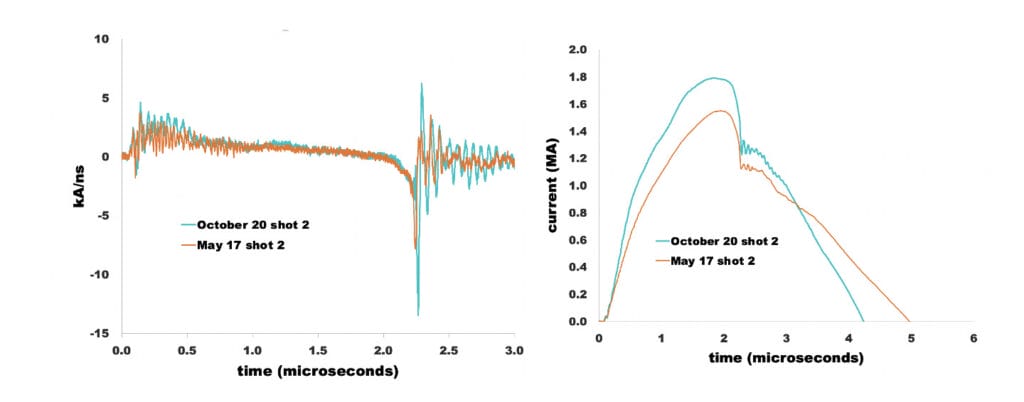We took a big step forward in the past week as we prepare for our proton-boron (or hydrogen-boron) fusion experiments. We’ve tripled our fusion energy yield from the experiments we did in May and substantially increased the peak electric current in the machine to a whopping 1.8 MA (million amps.) This puts us about halfway to where we need to be to start our experiments with proton boron fuel. One more such big step and we’ll be there!
For some time, we’ve been trying to optimize conditions within our FF-2B to get high plasma temperature and density together with the higher peak current and higher gas pressures that we’ve achieved with our new switches. Our immediate goal is to optimize these conditions with mixes of deuterium and other gases, which is what we have been working with for years. We will then transition to a mix with hydrogen and finally introduce small amounts of decaborane, our proton-boron fuel. In this way, we have the best chance to ensure we will get measurable fusion yield with the first shots of our limited supply of decaborane.
Back in May, when we first got our new switches working, the current in the machine increased by more than 25% and we doubled the gas pressure inside the machine, which has to be matched with the increasing current. Both of these changes should have increased fusion yield, but instead yield dropped. So did the speed of the pinch—the speed of the plasma as it is compressed into the tiny plasmoid where fusion occurs.
Since then, we’ve worked to understand why this happened and how to overcome it with the correct combination of gas mixes and pre-ionization currents (small currents that pave the way for the main pulse.) Last week we got a new insight into what was going wrong. When we fixed it, we got a big improvement, which we confirmed with a second even better shot. Further confirmation came on a third shot, when we deliberately reversed our improvement and saw performance go back down.
In our best shot (shot 2, Oct.20) the speed of the pinch, (as measured by the rate of change of the current) nearly doubled from May, going back to the range of our best shots ever. (Figure 1a,left). Even better, the fusion yield tripled to 60 mJ. The two shots together gave the best fusion yield of any two shots in the past four years. On top of that, the peak current itself increased by a significant 15% (figure 1 b, right) to 1.8 MA, a new record for FF-2B.
We still have a way to go to get to the conditions we need for proton-boron. We can determine from our data that the plasmoid temperature was 33 keV (the equivalent of 360 million K). While that seems pretty toasty, (it’s 30 times the temperature in the center of the sun) it is cooler than our record of 200 keV and the 150 keV we need to burn proton-boron fuel. So, we need a factor of five jump in temperature, which would also bring our fusion yield above the record that we achieved back in 2016. With our new understanding of some key processes, we think we can achieve that pretty quickly.
In the meantime, however, we always have some maintenance to do that slows us up. Dr. Syed Hassan will be switching out our main vacuum pump (running continuously for five years) for a spare pump early next week. After that, we hope to get back to firing and more optimization.

Figure 1. On right (a) the rate of change of the current is plotted against time, showing that our recent shot(blue line) has a much greater speed of compression at the pinch (downward spike at 2.25 microseconds) than our best shot back in May(orange line). Higher speed of compression leads to higher density and more fusion. On left(b) the new shot has a higher peak current than the May shot. Since both shots have the same amount of charge, the new one goes to zero quicker than the old one.
